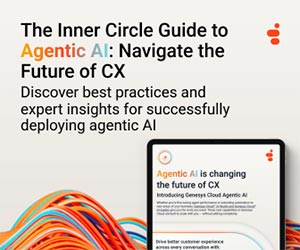Craig Pumfrey sets the record straight about voice biometrics.
In recent weeks voice biometrics has been hitting the headlines as the technology set to replace the bane of so many people’s lives. While there are a lot of misnomers out there, put simply, voice biometrics is a way to verify a person is who they say they are via their voice.
It works by taking a voiceprint of the customer, which is captured while they are speaking with the customer representative on the telephone. Then when they call again, their voice is matched within approximately 10 seconds, with the voiceprint kept on record. If a match is verified then the customer is authenticated.
The speed with which a customer’s identity can be matched is hugely compelling proposition for organisations that handle large numbers of calls, with as much as 50% of a call being consumed by the authentication process.
On the whole, reducing this time means you can handle more calls in the same timeframe and that means better efficiency and customers spending less time on-hold queuing.
Another reason for introducing voice biometrics is to reduce identity fraud. This is great for the business as it can help to save millions, but it also delivers an added level of protection to the customer, safeguarding them from the distress of having their identity stolen and needing to go through the subsequent and often lengthy claims processes.
For consumers perhaps the biggest benefit is that you now no longer have to remember a secret word, memorable phrase or password – you just need your voice.
However, talk about biometrics and people start worrying that big brother is watching. So, it is worth addressing some of the concerns both consumers and organisations have about the technology.
Customer Concern #1 – I don’t like the idea of an organisation holding my biometric information.
A voice biometric is simply a recording of your voice, nothing more. Every time you call a contact centre it is likely that the interaction will be recorded. You often get the message “this message may be recorded for training purposes”. All an organisation is doing is using your voice to help you to prove you are who you say you are.
Customer Concern #2 – If I have a cold or a sore throat my voice changes, so it won’t work.
The human voice is a hugely complex instrument that is made up of 50 physical and behavioural traits.
These include characteristics such as pronunciation, emphasis, speed of speech, accent, as well as physical elements such as the length of the vocal tract, mouth shape and size and nasal passage.
This means that even if you have a blocked nose, or even spoke in a different language, the system would still be able to match you with your voiceprint.
Customer Concern #3 – A person could impersonate me on the telephone.
There are some great impressionists out there and when you hear someone impersonate David Beckham, for example, it may sound to you exactly like him.
It is possible to fool our ears to give the ‘impression’ that it is David Beckham, it is impossible to mimic all of the 50 traits that make up his voice.
In fact, the ‘ears’ of these systems are so attuned that they can tell the difference between identical twins.
Customer Concern #4 – What if someone recorded a voice on their phone and played it down the telephone line?
Making a voiceprint of someone sounds as easy as pressing record but it really isn’t.
These systems are able to detect whether the person speaking at the other end of the line is actually there, or if it is a recording, irrespective of how good that recording is, or whether voice manipulation is being used.
Customer Concern #5 – If I make a call from a busy street the system won’t work.
The system is able to differentiate between your voice and background noise.
So, call from Leicester Square in London on a Saturday night after a few drinks and with slightly slurred speech and it will still be able to identify you.
That said, I would strongly urge against calling your bank if you are in that condition!
Customer Concern #6 – Can an organisation create my voiceprint without my consent?
This very much depends on the laws of the land, but regardless, most organisations recognise that the best way to introduce voice biometrics is to do so with the consent of the customer, along with an explanation of the benefits it will offer, over and above current methods of authentication.
None of us likes having to use passwords, but they have been inflicted on us for so long that they have almost been accepted as a necessary evil. So, it is perhaps only human nature to be wary of change. After all, what we use them to safeguard is valuable.

Craig Pumfrey
However, we have become saturated with passwords, memorable words and pass-codes, and as a result we use the same one over and over again, which compromises security, or we constantly and with great inconvenience reset them.
So, if we want something that is unique to us, cannot be copied, or forgotten and can be used to prove our identity quickly and securely, our voice could be the answer.
With thanks to Craig Pumfrey, Director of Marketing and Communications at NICE Systems
Author: Megan Jones
Published On: 9th Jul 2014 - Last modified: 9th Sep 2024
Read more about - Archived Content, Biometrics, Craig Pumfrey, NiCE





























